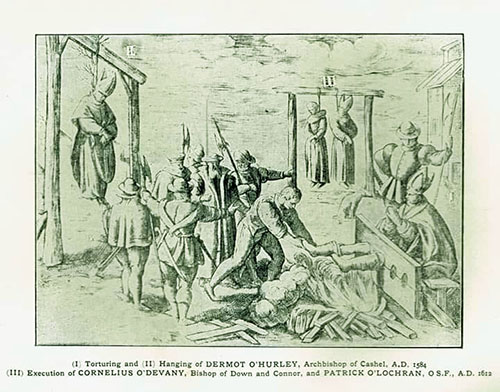hierlihy history


Hierlihy Heraldry and History
From Your Irish Ancestors by J. Anderson Black |
Excerpt from Page 192
“O’Hurley . . .
Gaelic: O’hUrthhuile
Common Variations: Hurley, O’Herlihy
This very common surname is the anglicized form of two distinct Gaelic names, O’huirthile of Thomond and O’Muirthile or O’Murghaile of County Cork. The Thomond Hurleys are now found mainly in County Limerick although their original homeland was in County Clare. The vast majority of Hurleys in Ireland today however come from County Cork and are sometimes, though rarely called Murley. Their ancestral territory was situated near Kilbritain in Carbery East, County Cork.
Dermot O’Hurley (1519 – 1584) Archbishop of Cashel, is noted for his act of martyrdom in defiantly refusing to acknowledge the ‘Queen’s religion’ in Ireland. Born in County Limerick, he was educated at Paris and Louvain and in 1581 appointed to the see of Cashel. But soon after he arrived to take up his post he was arrested ‘bearing treasonable papers’ and subjected to excruciating torture. The executioners placed the Archbishop’s feet and calves in tin boots filled with oil; then they fastened his feet in wooden shackles, or stocks, and placed fire under them. The boiling oil so penetrated the feet and legs that morsels of the skin, and even flesh, fell off and left bone bare’. The Archbishop reluctantly refused to purchase a cessation of his torments by acknowledging the Queen’s supremacy in matters of religion. An end was put to his sufferings by his being hanged on a tree outside of Dublin, 19 June 1584.
Patrick Hurley (d. 1700) led an adventurous and infamous career as an informer and self-styled ‘Count of Mountcallan’ . . .”
From Irish Pedigrees by John O’Hart |
Excerpt from page 100
“… The stem of the ‘Macnamara’ Pedigree Lords of Bunratty, County Clare. … URTHUILE ( ‘ur’ ; Irish, recent, ‘tuile’ ; a flood, a torrent) : his son ; a quo O’h-Urthuile ; anglicised Harley, Hurley, Herlihy, Flood-Torrens.”
From A Genealogical History of the Milesian Families of Ireland Compiled by Heraldic Artists Limited |
Excerpt from Page 67
“… Various modes of spelling Irish names of Milesian descent : Herlihy, Hurlihy, Harlihy.”
Excerpt from Page 79
“… The O’Herlihys or O’Hurleys were chiefs of a district in the barony of Muskerry. O’Heerin states that they were hereditary wardens of the church of St. Gobnait of Ballyvoorny, and were possessors for many ages of the large parish of that name.”
From Irish Names and Surnames by Reverend Patrick Woulfe |
Excerpt from Page 577
“… Ohurtuile – I – OHurrilly, O’Hurley, Hurley ; des of Urthuile ; … the name of a Dalcassian family in Thomond, akin to those of O’Moloney and O’Kearney ; now dispersed throughout Munster. An important branch of the family settled at Knocklong, in the last of County Limerick, where remains of their castle is still a conspicuous object on the hill of Knocklong, and commands a magnificent view of the Galtee Mountains and the plain of County Limerick.”